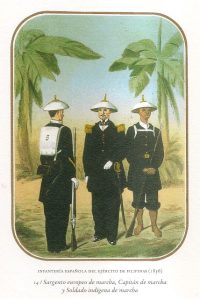Día 7.– Marché y de dia claro: después de atravesar un pequeño valle empezamos á descender por un cogon muy espeso; marchábamos muy despacio porque encontramos el camino cortado con árboles atravesados y una porción de estorbos. A las nueve oímos grandes gritos y vimos una gran porción de igorrotes en la cordillera opuesta armados: en seguida ya no era posible marchar; el camino estaba cubierto de pequeñas cañas clavadas en el suelo, muy puntiagudas y algunas de palma brava; hoyos profundos cubiertos con zacate y en su centro unas lanzas de caña; también había otro género de trampas que llaman los infieles balitil, que consiste en tener dos arcos tirantes con la flecha escondidos en cada lado en el cogon; de esos arcos sale una cuerdecita muy encubierta tendida en el suelo; al pisar esa cuerda parten las dos flechas con tal rapidez, que pueden atravesar sin dificultad un carabao; las hay que apuntan al cuerpo, otras á las piernas. Fué preciso poner diez hombres por delante que poco á poco y con mil dificultades y riesgos quitasen una á una las trampas, las que en menos de una hora hirieron y me inutilizaron un sargento y 14 hombres que fué luego menester cargar. En fin, á la una de la tarde llegamos al fondo de un barranco donde encontramos un río que se llama Cagaling, que es el que pasa por Aringay y toma nacimiento en el Tonglo. De prisa y corriendo comimos los ranchos, pues teníamos los igorrotes en un altura que dominaba y nuestra posición era muy crítica, por lo que trataba de ganar la altura para pasar la noche con más seguridad. A las tres de la tarde empecé á subir al SE. á la mitad de la cuesta, que era muy pendiente, pedregosa y resbaladiza. Nos asaltaron los igorrotes con una nube de piedras; mas una descarga que les mandé los puso en fugoa, dejándoles un hombre muerto que se llevaron cargado. A las cinco y media llegamos á una llanurita en el lomo de un monte donde campé y pasé la noche que fué cruel, pues nos llovió mucho toda ella. Este sitio es pintoresco; teníamos en frente á poquísima distancia el monte Tonglo, al que habíamos un pueblo; un gran cascada de agua se precipitaba en el río Cagaling que teníamos á los pies; al E. colinas graciosas cubiertas de verdura; al S. divisamos bosques immensos de pinos; aquí y allá alguna choza.
Seventh day. I started at daylight. After crossing a small valley we began descending through very dense cogon. We advanced very slowly, as we found the trail blocked up with trees laid across it, and a number of other obstructions. At 9 o’clock we heard wild shouts and perceived a crowd of armed Igorot on the opposite range. At the same it became impossible to advance. The path was beset with small, very sharp-pointed pieces of bamboo, and some of palma brava* driven into the ground, and with deep pitfalls covered with grass and furnished with bamboo spears in the center. There was also another kind of trap, called “balitil” by the pagans, which is made by placing two drawn bows with arrows ready to let fly, concealed in the high cogon grass, one at each side of the trail. From these hows a small and well-concealed string leads to the path, and when this string is trodden on the two arrows fly off with such force as to pass easily through a carabao. 1 Of these arrows, some are aimed so as to hit the body, others the legs. It was necessary to order ten men to the front who, little by little and with great difficulty and risk, removed the traps one by one, but not before these had wounded and disabled in less than an hour a sergeant and fourteen men, who afterwards had to be carried. Finally at 1 in the afternoon we reached the bottom of a ravine, where we found a river called the “Cagaling,” which is the same stream that flows past Aringay and has its source on Mount Tonglo. We took our rations in all haste, as the Igorot were in a commanding position and our situation was critical. For this reason I wished to gain the height in order to pass the night in greater safety. At 3 in the afternoon I commenced the ascent toward the southeast. Halfway up the slope, which was very steep, rocky, and slippery, the Igorot attacked us with a shower of stones, but a volley from our side put the enemy to flight, with the loss of one man killed, whom they carried off. At half past 5 we arrived at a small level place on the flank of a mountain. We built our camp here and passed a miserable night, during which it did not cease to rain. This spot is very picturesque. At a short distance in front we had Mount Tonglo, round which we had walked and upon which we discerned a village; a big waterfall rushed down into the Cagaling River at our feet; toward the east were graceful hills covered with green, and toward the south immense pine forests with here and there a hut.
1 A tract of tall, sharp grass, often as a high as a man on horseback. [TRANSLATOR.]
2 Coripha minor. [TRANSLATOR.]
